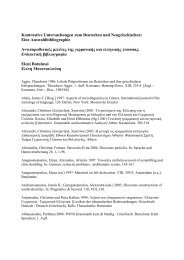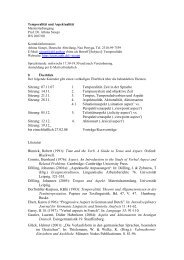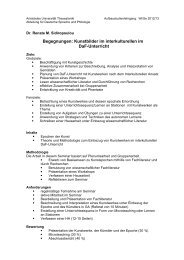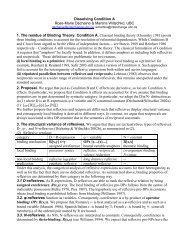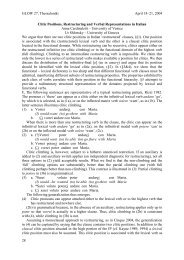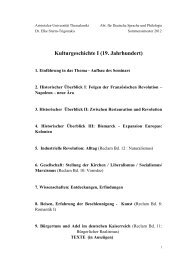Pascual Masullo (Pittsburgh) and Marcela Depiante
Pascual Masullo (Pittsburgh) and Marcela Depiante
Pascual Masullo (Pittsburgh) and Marcela Depiante
Create successful ePaper yourself
Turn your PDF publications into a flip-book with our unique Google optimized e-Paper software.
GLOW 27, Thessaloniki April 18–21, 2004<br />
44<br />
Gender is in the Lexicon, Number is in the Syntax:<br />
Evidence from Nominal Ellipsis in Spanish<br />
<strong>Pascual</strong> José <strong>Masullo</strong>, University of <strong>Pittsburgh</strong>, pascual@pitt.edu<br />
<strong>Marcela</strong> <strong>Depiante</strong>, Universidad del Comahue (Argentina), depiantem@yahoo.com<br />
It has been traditionally assumed that while gender is a lexical feature, number inflection is<br />
determined post-lexically. This paper claims that the behavior of nominal ellipsis in Spanish<br />
confirms this traditional view. As (1) below shows, while a mismatch in number is allowed<br />
between antecedent <strong>and</strong> elided element, ellipsis requires a match in gender features (a<br />
phenomenon noted by Brucart 1999, among others):<br />
(1) a. Juan visitó a sus tíos y Pedro visitó al tío suyo.<br />
John visited his uncles <strong>and</strong> Peter visited the (MASC-SING) his.<br />
“John visited his uncles <strong>and</strong> Peter visited his uncle.”<br />
b. * Juan visitó a su tío y Pedro visitó a la tía suya.<br />
John visited his uncle <strong>and</strong> Peter visited the (FEM-SING) his.<br />
“John visited his uncle <strong>and</strong> Peter visited his aunt”.<br />
This is reminiscent of the different behavior of main <strong>and</strong> auxiliary verbs with respect to<br />
ellipsis, noted by Lasnik (1995):<br />
(2) a. John slept soundly <strong>and</strong> Mary will sleep too.<br />
b. *John was here <strong>and</strong> Mary will be too.<br />
c. ?? John was sleeping soundly <strong>and</strong> Mary will be sleeping too.<br />
To account for the contrast in (2), Lasnik ab<strong>and</strong>ons Chomsky’s (1993, 1995)<br />
assumption that all elements enter the computational system fully inflected, <strong>and</strong> proposes a<br />
mixed system instead: while auxiliary verbs are already inflected in the numeration, main<br />
verbs enter the syntactic component without any inflectional markings. If this is so, Lasnik<br />
argues, at some point in the derivation we will have the representation (3) for (2a), in which<br />
the required identity between antecedent <strong>and</strong> elided element (viz. sleep) is guaranteed:<br />
(3) John T PRET sleep soundly <strong>and</strong> Mary will sleep too.<br />
We will assume that ellipsis consists in a deletion process at PF under formal identity<br />
(Chomsky & Lasnik 1993, Sag 1976, among others), <strong>and</strong> that the elided element in (1) above<br />
is the actual head noun <strong>and</strong> not a higher projection, as in the case of NP-ellipsis in English<br />
(Contreras 1989). If, moreover, we (partially) extend Lasnik’s mixed system to the nominal<br />
domain, we can account for the contrast in (1): Just like main verbs <strong>and</strong> T, N <strong>and</strong> Number<br />
enter the computational system separately. This will ensure the required identity for ellipsis in<br />
the case of (1a) prior to the overt movement of N to Number, as is shown in (4a). In contrast,<br />
if gender is an intrinsic feature of the noun, so that at no point in the derivation is the noun<br />
stem detached from its gender feature, we can’t obtain identity between the nouns involved in<br />
the case of (1b), <strong>and</strong> so ellipsis is not licensed, as is shown in (4b).<br />
(4) a. Juan visitó a su Num PL tío MASC y Pedro visitó al Num SG tío MASC suyo.<br />
b. * Juan visitó a su tío MASC y Pedro visitó a la tía FEM suya.<br />
Although number in Spanish is generally a variable feature (syntactically acquired, as<br />
we have seen), it can sometimes be intrinsic. Thus, some nouns are always plural, regardless
Main Session Abstracts<br />
of meaning (albricias “good tidings”, bodas “wedding”, noticias “news”, etc.). Our analysis<br />
therefore predicts that this kind of noun will not be able to license ellipsis of a singular but<br />
otherwise identical noun (in the few cases where this is possible). The unacceptability of (5)<br />
below bears out our prediction, lending further support to the analysis we have proposed:<br />
(5) ?? Las noticias de la televisión y la noticia de la radio no coinciden.<br />
The news of the TV <strong>and</strong> the news of the radio do not agree.<br />
“The news on the TV <strong>and</strong> those on the radio do not agree”.<br />
While nominal ellipsis prohibits a gender mismatch, ellipsis of nominal modifiers<br />
(quantifiers, adjectives, etc.) does not require gender identity (6), which might be taken as a<br />
serious counterexample to the proposal that gender is lexically determined:<br />
(6) El niño es bueno y la niña es buena también.<br />
The boy is good-MASC <strong>and</strong> the girl is good-FEM too.<br />
However, if we recall that the gender markings on adjectives <strong>and</strong> determiners in Romance<br />
result from agreement with the noun they modify, our proposal is reinforced, since these must<br />
necessarily enter the computational system without any gender specification. Thus, before<br />
noun modifiers acquire their gender (the mechanism whereby they do so is irrelevant for our<br />
purposes), the formal identity required for ellipsis is obtained:<br />
(7) El niño MASC es buen- y la niña FEM es buen- también.<br />
The following example of a related phenomenon in English (one-substitution) might<br />
also be construed as a counterexample:<br />
(8) I have a neighbor who once played third base for the White Sox, <strong>and</strong> I have one who was Miss<br />
Georgia of 1976 (McCawley 1998, p. 371).<br />
This apparent problem can be solved, however, once we realize that nouns like neighbor are<br />
not ambiguous with respect to gender, but rather referentially vague, i.e. the natural gender<br />
(or sex) of the referent must be pragmatically determined. There is no actual gender feature<br />
associated with this kind of noun, <strong>and</strong> so the formal identity required (in this case, for onesubstitution)<br />
is once again ensured.<br />
Finally, in light of the data examined, we will briefly consider the controversy over<br />
the need to postulate both Number <strong>and</strong> Gender projections within DP (as in Picallo 1991,<br />
Bernstein 1991), or only a Number projection (as in Ritter 1991).<br />
45



